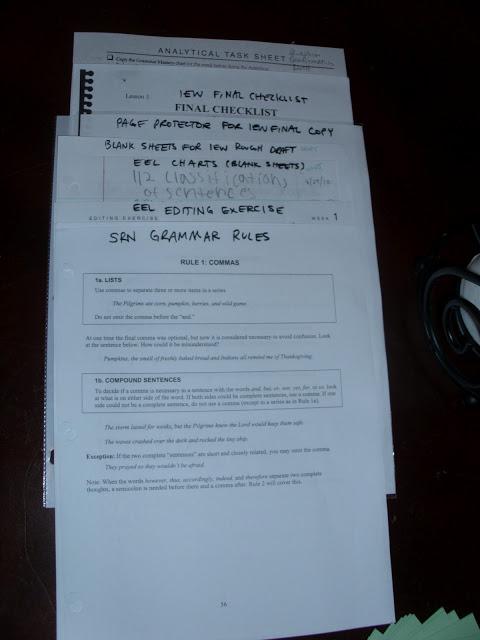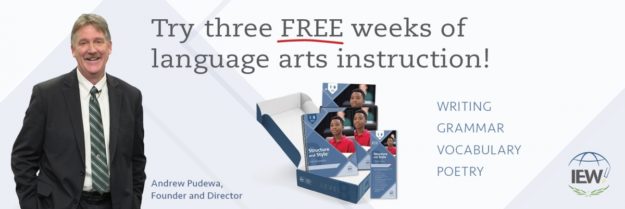We’ve made a few simple updates to our Essentials student practice notebook, and… it’s working!
I thought I’d share what we’re doing in case others may find it useful… (or muse that it’s taken me this long to figure out something so simple…)
All of the reference master charts are in page protectors (for durability) and stored at the front of the notebook, as stated in our previous Preparing for Essentials post. Again, the reference charts that we’ve placed in page protectors are:
- Grammar Mastery Charts (pg. 395)
- EEL Scope & Sequence (pg. 18)
- Weekly Practice Sentences (pg.433-434)
- Charts A-Q Masters Only (found in pgs 398-431)
- Quid et Quo Charts (pg. 437 & 439)
- Punctuation & Capitalization Rules (pg 457)
- Spelling Rules (463-464)
- Parts of Speech Definition (pg. 443)
- Glossary of Abbreviations (pg. 394)
- List of Question Confirmation Questions (homemade)
- List of Tasks #1-6 (homemade)
Right now the Student Resource Notebook (SRN) is in a separate 1/2-inch binder, but we may end up putting the SRN reference lists (-ly words, quality adjectives, etc.) in this notebook as well. (For those who are wondering what in the world a Student Resource Notebook is, it’s the free download that you receive when you purchase the IEW history-based lessons workbook. Because of IEW’s 100% Money-Back Guarantee, we recommend purchasing the History-Based Writing Lessons directly from IEW: Ancient History-Based Writing Lessons (Cycle 1), Medieval-Based Writing Lessons (Cycle 2), or U.S. History-Based Writing Lessons (Cycle 3).)
Now, this is the part that’s different from last year which has proven so successful for us. Following the reference charts, we have 12 dividers labeled Week 1 – Week 12 (for first semester). For those wanting to keep a smaller notebook, try 6 weeks at a time instead of 12. Behind each week’s divider, I’ve included the following:
- A blank page for Mom’s handwritten checklist of what we need to accomplish for next week. (I do this before we leave class so we don’t forget anything!) I include a list of charts to practice (and how may times for each and which day), a list of that week’s definitions to learn and recite (and review!), a reminder to practice vocabulary, and a reminder to do a Question Confirmation Drill. I also write out how we will tackle our IEW assignment (on which days we will do what).
- A copy of the IEW Student Resource Notebook Grammar Rules Page (1 rule per week; repeat second semester; include an extra rule somewhere to cover all 13 rules in 12 weeks.) Recent updates to the Student Resource Notebook have not included the Grammar Rules section, so these may not be available in your version.
- A copy of the EEL Editing Exercise for the week (we don’t always complete this, but it’s there just in case – AND it contains the week’s punctuation/capitalization rule, spelling rule, and homophones). Alternatively, our family has used Fix It Grammar (try a sample here), which has provided a more structured method of learning sentence mechanics and proofreading skills.
- Oral Question Confirmation Drill (Download an example of a drill for Questions 1 through 4. I was originally handwriting random sentences but finally decided to type it up.) For more information on the Question Confirmation Process, download some examples by clicking on the numbers after the words “practice sheets” on the Shurley Grammar’s website. Here’s an example for Level 2 of Shurley English Grammar.
- Blank sheets of paper for EEL Chart Practice (usually 2-3 charts per day on paper using the abbreviations on pg. 394)
- Five copies of the Analytical Task Sheet (one for each of the Weekly Sentences).
- Blank notebook paper for IEW Rough Draft
- An empty page protector for IEW Paper: Final Copy & Checklist, and Rough Draft. (It’s great to have all the IEW checklists copied off ahead of time, especially if you have a tutor that wants that checklist attached!)
Then I label each page with the date the student is supposed to complete it.
With these pages in place, our son only needs to open the student notebook to the current week, and he’ll work through the pages according my my handwritten note and the dates listed at the top of each page. As a list, this looks complicated. In real life, it is not. It just takes a little upfront copying and organization to get everything in place. Then it works on autopilot quite nicely. And I love autopilot!
Now… why didn’t I figure out last year that having a notebook with the right number of photocopies and the right number of blank pieces of paper would help us so much? I have no idea.
My last confession is that we also practice charts orally by using an “Essentials” CD that I made with CC Connected songs from all three cycles of memory work. In fact, we primarily practiced our charts out loud last year because of our then third-grader’s aversion to writing. But this year he has been able to write quite a bit more, so we’ve increased the number of written charts. For those who are curious, there were (at one time) over 30 songs from NoGreaterJoy5 on CC Connected’s Essentials-Tier File Sharing. There’s an additional monthly fee to subscribe to the Essentials Tier, but there are several great Essentials resources available on file sharing that are not available on the Foundations Tier. (UPDATE: The songs we selected were from before the CC Connected update from 4th to 5th edition in Summer 2018. I cannot offer this CD for sell, nor can I share the files due to copyright, but you can subscribe to the paid Foundations tier of CC Connected and browse through the audio files to see what you like. At one time, you could also find chart songs on the Essentials tier of CC Connected. We are no longer subscribed to CC Connected and no longer participate in Classical Conversations, so I cannot recommend specific songs, nor do I know what’s currently available.)
Try out Writing, Spelling, Poetry, and Grammar Programs for Free!
We highly recommend checking out the first three weeks of Structure & Style for Students program from IEW. (You can access the first three weeks free.)
Other IEW programs you can try out for free include…
- Structure and Style for Students. If you’d prefer Andrew Pudewa to teach writing structure and style to your student(s), this program is for you! Download the first lessons from each level for teaching composition to children in grades 3-12.
- Fix It! Grammar. Download the first lessons of all four levels of this gentle introduction to grammar and mechanics with thorough yet simple instructions for the teacher.
- Introduction to Public Speaking. Download the first two lessons of this engaging program for learning to conquer the #1 fear of most people: public speaking.
- University-Ready Writing is a 12-week video-based course which teaches high school students advanced note-taking skills and writing techniques in preparation for college-level writing. Try it free here!
- Theme-Based Writing Lessons. Theme-Based Writing Lessons are for students and/or teachers familiar with IEW’s Structure and Style Program. Topics include science, history, literature, and Bible, covering a variety of grade levels.
- Linguistic Development through Poetry Memorization. Download the first five poems from this mastery approach to learning poetry.
- The Phonetic Zoo. Try a sample of a program that teaches spelling with an auditory approach towards mastery. (Requires free registration.)
- Free audio talks, booklists, and more! (Our favorite audio is Nurturing Competent Communicators.)
Visit IEW to find out more about other programs to transform your students into proficient writers – from early elementary all the way through college! You may also be interested in our favorite resources for teaching grammar and composition to students in grades 3-12. Because of IEW’s incredible 100% Money-Back Guarantee, we highly recommend purchasing products directly from IEW instead of through 3rd-party sellers.
For other posts on Essentials visit:
- A First-Year Survival Guide
- Preparing for Essentials
- The Stick-and-the-Sand and Your Essentials Guide
- Our Essentials Experience – How to Scale Back
And be sure to download Shurley Grammar’s free Parent Help Booklets and Student Practice Sheets! Super, super helpful!


